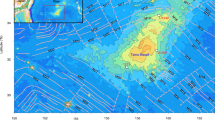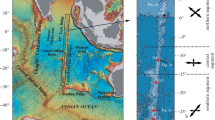Abstract
This study investigates the relationship between the hotspot-ridge interaction and the formation of oceanic plateaus and seamounts in the Southwest Indian Ocean. We first calculated the relative distance between the Southwest Indian Ridge (SWIR) and relevant hotspots on the basis of models of plate reconstruction, and then calculated the corresponding excess magmatic anomalies of the hotspots on the basis of residual bathymetry and Airy isostasy. The results reveal that the activities of the Marion hotspot can be divided into three main phases: interaction with the paleo-Rodrigues triple junction (73.6-68.5 Ma), interaction with the SWIR (68.5-42.7 Ma), and intra-plate volcanism (42.7-0 Ma). These three phases correspond to the formation of the eastern, central, and western parts of the Del Cano Rise, respectively. The magnitude and apparent periodicity of the magmatic volume flux of the Marion hotspot appear to be dominated by the hotspot-ridge distance. The periodicity of the Marion hotspot is about 25 Ma, which is much longer than that of the Hawaii and Iceland hotspots (about 15 Ma).
Similar content being viewed by others
References
Wessel P. Sizes and ages of seamounts using remote sensing: Implications for intraplate volcanism. Science, 1997, 277: 802–805
Morgan W. Rodriguez, Darwin, Amsterdam, a second type of hotspot island. J Geophys Res, 1978, 83: 5355–5360
Escartín J, Cannat M, Pouliquen G, et al. Crustal thickness of V-shaped ridges south of the Azores: Interaction of the Mid-Atlantic Ridge (36°–39°N) and the Azores hot spot. J Geophys Res, 2001, 106: 21719–21735
Van Ark E, Lin J. Time variation in igneous volume flux of the Ha waii-Emperor hot spot seamount chain. J Geophys Res, 2004, 109: B11401, doi: 10.1029/2003JB002949
Mjelde R, Faleide J. Variation of Icelandic and Hawaiian magmatism: Evidence for co-pulsation of mantle plumes? Marine Geophys Res, 2009, 30: 61–72
Ito G, Lin J. Oceanic spreading center-hotspot interactions: Constraints from along-isochron bathymetric and gravity anomalies. Geology, 1995, 23: 657–660
Maia M, Goslin J, Gente P. Evolution of the accretion processes along the Mid-Atlantic Ridge north of the Azores since 5.5 Ma: An insight into the interactions between the ridge and the plume. Geochem Geophys Geosyst, 2007, 8: Q03013, doi: 10.1029/2006GC 001318
Vidal V, Bonneville A. Variations of the Hawaiian hot spot activity revealed by variations in the magma production rate. J Geophys Res, 2004, 109: B03104, doi: 10.1029/2003JB002559
Adam C, Vidal V, Escartín J. 80-Myr history of buoyancy and volcanic fluxes along the trails of the Walvis and St. Helena hotspots (South Atlantic). Earth Planet Sci Lett, 2007, 261: 432–442
Jokat W, Ritzmann O, Schmidt-Aursch M C, et al. Geophysical evidence for reduced melt production on the Arctic ultraslow Gakkel mid-ocean ridge. Nature, 2003, 423: 962–965
Gente P, Dyment J, Maia M, et al. Interaction between the Mid-Atlantic Ridge and the Azores hot spot during the last 85 Myr: Emplacement and rifting of the hot spot-derived plateaus. Geochem Geophys Geosyst, 2003, 4: 8514, doi: 10.1029/2003GC000527
Dick H J B, Lin J, Schouten H. An ultraslow-spreading class of ocean ridge. Nature, 2003, 426: 405–412
Tao C, Lin J, Guo S, et al. First discovery and investigation of a high temperature hydrothermal vent field on the ultraslow spreading Southwest Indian Ridge. EOS Trans AGU Fall Meet Suppl Abstract, 2007. T52B-07
Goslin J, Patriat P. Absolute and relative plate motions and hypotheses on the origin of five aseismic ridges in the Indian Ocean. Tectonophys, 1983, 101: 221–244
Coffin M F, Eldholm O. Large Igneous Provinces: Crustal structure, dimensions, and external consequences. Rev Geophys, 1994, 32: 1–36
Sinha M C, Louden K E, Parsons B. The crustal structure of the Madagascar Ridge. Geophys J Roy Astro Soc, 1981, 66: 351–377
Smith W H F, Sandwell D T. Global sea floor topography from satellite altimetry and ship depth soundings. Science, 1997, 277: 1956–1962
Müller R D, Sdrolias M, Gaina C, et al. Age, spreading rates, and spreading asymmetry of the world’s ocean crust. Geochem Geophys Geosyst, 2008, 9: Q04006, doi: 10.1029/2007GC001743
Patriat P, Segoufin J. Reconstruction of the central Indian Ocean. Tectonophys, 1988, 155: 211–234
Cannat M, Rommevaux-Jestin C, Sauter D, et al. Formation of the axial relief at the very slow spreading Southwest Indian Ridge (49° to 69°E). J Geophys Res, 1999, 104: 21825–21843
Meyzen C M, Ludden J N, Humler E, et al. New insights into the origin and distribution of the DUPAL isotope anomaly in the Indian Ocean mantle from MORB of the Southwest Indian Ridge. Geochem Geophys Geosyst, 2005, 6: Q11K11, doi: 10.1029/2005GC000979
Font L, Murton B J, Roberts S, et al. Variations in melt productivity and melting conditions along SWIR (70°E-49°E): Evidence from olivine-hosted and plagioclase-hosted melt inclusions. J Petrol, 2007, 48: 1471–1494
Mendel V, Sauter D, Rommevaux-Jestin C, et al. Magmatic-tectonic cyclicity at the ultra-slow spreading Southwest Indian Ridge: Evidence from variations of axial volcanic ridge morphology and abyssal hills pattern. Geochem Geophys Geosyst, 2003, 4: 9102, doi:10.1029/2002GC000417
Sauter D, Patriat P, Rommevaux-Jestin C, et al. The Southwest Indian Ridge between 49°15′E and 57°E: Focused accretion and magma redistribution. Earth Planet Sci Lett, 2001, 192: 303–317
Georgen J E, Lin J, Dick H J B. Evidence from gravity anomalies for interactions of the Marion and Bouvet hotspots with the Southwest Indian Ridge: Effects of transform offsets. Earth Planet Sci Lett, 2001, 187: 283–300
Muller M R, Minshull T A, White R S. Crustal structure of the Southwest Indian Ridge at the Atlantis II Fracture Zone. J Geophys Res, 2000, 105: 25809–25828
Muller M R, Minshull T A, White R S. Segmentation and melt supply at the Southwest Indian Ridge. Geology, 1999, 27: 867–870
Minshull T A, Muller M R, White R S. Crustal structure of the Southwest Indian Ridge at 66°E: Seismic constraints. Geophys J Int, 2006, 166: 135–147
Goslin J, Segoufin J, Schlich R, et al. Submarine topography and shallow structure of the Madagascar Ridge, western Indian Ocean. Geol Soc Am Bull, 1980, 91: 741–753
Duncan R A, Richards M A. Hotspots, mantle plumes, flood basalts, and true polar wander. Rev Geophys, 1991, 29: 31–50
Muller RD, Royer J Y, Lawver L A. Revised plate motions relative to the hotspots from combined Atlantic and Indian Ocean hotspot tracks. Geology, 1993, 21: 275–278
Storey M, Mahoney J, Saunders A D, et al. Timing of hot spot-related volcanism and the breakup of Madagascar and India. Science, 1995, 267: 852–855
Goslin J, Diament M. Mechanical and thermal isostatic response of the Del Cano Rise and Crozet Bank (southern Indian Ocean) from altimetry data. Earth Planet Sci Lett, 1987, 84: 285–294
Recq M, Goslin J, Charvis P, et al. Small-scale crustal variability within an intraplate structure: the Crozet Bank (southern Indian Ocean). Geophys J Int, 1998, 134: 145–156
Mahoney J J, White W M, Upton B G J, et al. Beyond EM-1: Lavas from Afanasy-Nikitin Rise and the Crozet Archipelago, Indian Ocean. Geology, 1996, 24: 615–618
Curray J R, Munasinghe T. Origin of the Rajmahal Traps and the 85° E Ridge: Preliminary reconstructions of the trace of the Crozet hotspot. Geology, 1991, 19: 1237–1240
Divins D L. Thickness of sedimentary cover in the Eastern Pacific Ocean. In: Udintsev G B, ed, International Geological-Geophysical Atlas of the Pacific Ocean. 2003. 120, 126, 127, 130
McKenzie D. Some remarks on the development of sedimentary basins. Earth Planet Sci Lett, 1978, 40: 25–32
Parsons B, Sclater J. An analysis of the variation of ocean floor bathymetry and heat flow with age. J Geophys Res, 1977, 82: 802–827
Stein C A, Stein S. A model for the global variation in oceanic depth and heat flow with lithospheric age. Nature, 1992, 359: 123–129
Crough S T. The correction for sediment loading on the seafloor. J Geophys Res, 1983, 88: 6449–6454
Sauter D, Cannat M, Meyzen C, et al. Propagation of a melting anomaly along the ultraslow Southwest Indian Ridge between 46°E and 52°20′E: Interaction with the Crozet hotspot? Geophys J Int, 2009, 179: 687–699
Tucholke B E, Lin J. A geological model for the structure of ridge segments in slow spreading ocean crust. J Geophys Res, 1994, 99: 11937–11958
DeMets C, Gordon R, Argus D, et al. Current plate motions. Geophys J Int, 1990, 101: 425–478
White R S. Melt production rates in mantle plumes. Phil Trans Roy Soc Lond Ser A-Phys Engineering Sci, 1993, 342: 137–153
Wessel P. An empirical method for optimal robust regional-residual separation of geophysical data. Math Geol, 1998, 30: 391–408
O’Neill C, Muller D, Steinberger B. Geodynamic implications of moving Indian Ocean hotspots. Earth Planet Sci Lett, 2003, 215: 151–168
Douglass J, Schilling J G, Kingsley R H, et al. Influence of the discovery and Shona mantle plumes on the Southern Mid-Atlantic Ridge: Rare Earth evidence. Geophys Res Lett, 1995, 22: 2893–2896
Muller R D, Roest W R, Royer J Y. Asymmetric sea-floor spreading caused by ridge-plume interactions. Nature, 1998, 396: 455–459
Morgan W J. Deep mantle convection plumes and plate motions. AAPG Bull, 1972, 56: 203–213
Kent W, Saunders A D, Kempton P D, et al. Rajmahal basalts, eastern India: Mantle sources and melt distribution at a volcanic rifted margin. AGU Geophys Monogr, 1997, 100: 145–182
Courtillot V, Davaille A, Besse J, et al. Three distinct types of hotspots in the Earth’s mantle. Earth Planet Sci Lett, 2003, 205: 295–308
Wessel P, Smith W H F. New version of the Generic Mapping Tools released. EOS Trans AGU, 1995, 76: 329
Author information
Authors and Affiliations
Corresponding author
Rights and permissions
About this article
Cite this article
Zhang, T., Lin, J. & Gao, J. Interactions between hotspots and the Southwest Indian Ridge during the last 90 Ma: Implications on the formation of oceanic plateaus and intra-plate seamounts. Sci. China Earth Sci. 54, 1177–1188 (2011). https://doi.org/10.1007/s11430-011-4219-9
Received:
Accepted:
Published:
Issue Date:
DOI: https://doi.org/10.1007/s11430-011-4219-9




